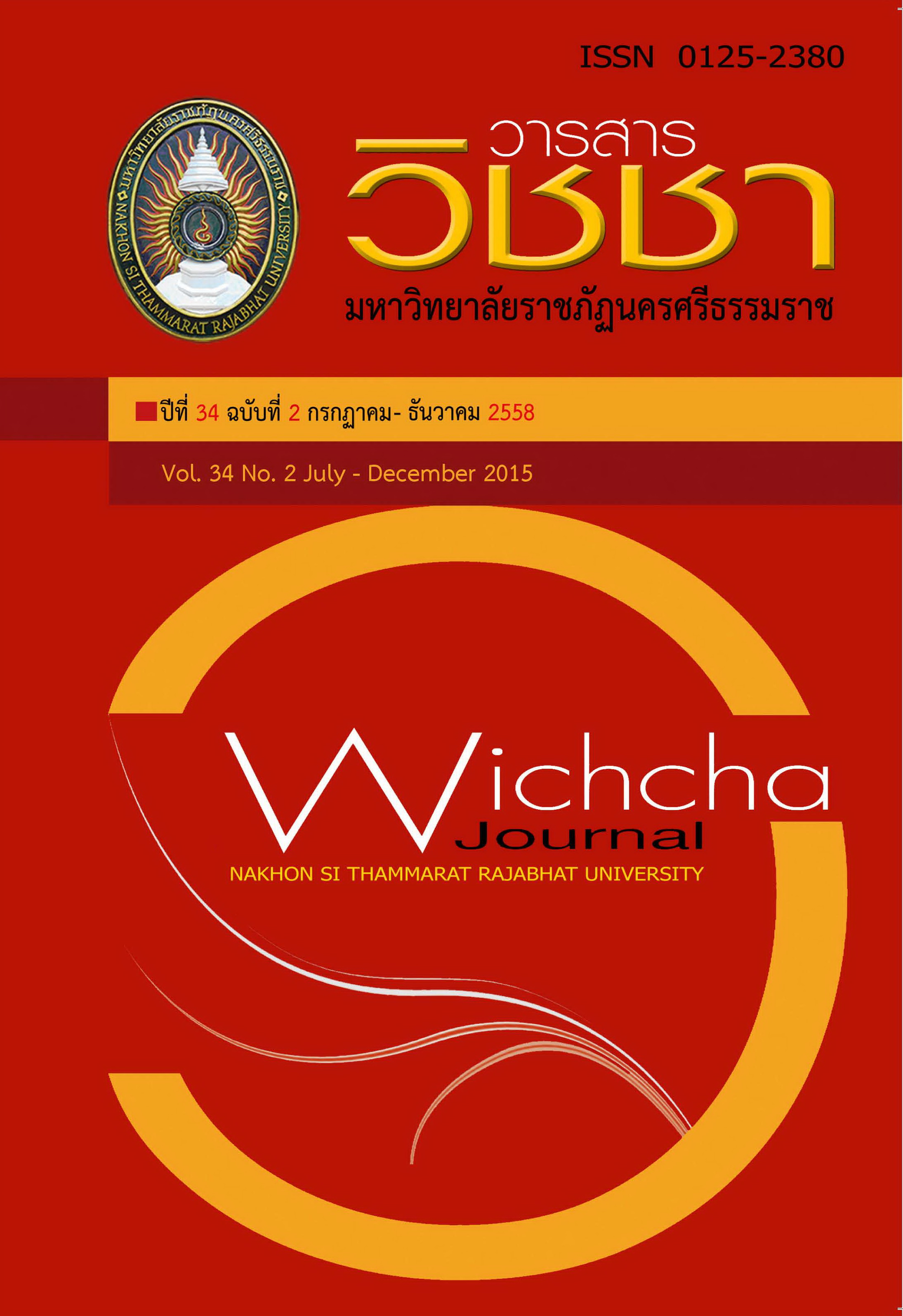การพัฒนาวิธีตรวจวัดปริมาณเหล็กในหอยแครงด้วยอุปกรณ์ปฏิบัติการบนกระดาษ โดยวิธีคัลเลอริเมตรี The Development for Analysis of Iron in Cockles with Paper-based Devices by Colorimetry
Main Article Content
Abstract
การพัฒนาวิธีตรวจวัดด้วยคัลเลอริเมตรี สำหรับวิเคราะห์ปริมาณเหล็ก (II) ในหอยแครงด้วยอุปกรณ์ปฏิบัติการบนกระดาษ สร้างอุปกรณ์ตรวจวัดโดยการสกรีนด้วยเทียนบนกระดาษกรองเพื่อกำหนดส่วนไม่ชอบน้ำ การตรวจวัดเหล็ก (II) อาศัยการเกิดปฏิกิริยาของเหล็ก (II) และ 1,10-phenanthroline จะให้สารประกอบเชิงซ้อนสีส้มแดงซึ่งอยู่ในรูปของ [Fe(phen)3]2+ สีบริเวณตรวจวัดจะเกิดการเปลี่ยนแปลงทันทีเมื่อมีสารละลายเหล็ก (II) ซึ่งการเปลี่ยนแปลงของสี จะขึ้นกับความเข้มข้นของเหล็ก (II) การทดสอบสารรบกวนด้วยโลหะชนิดต่าง ๆ พบว่าไม่ส่งผลต่อการเปลี่ยนแปลง ความเข้มสีของการวิเคราะห์เหล็ก (II) บันทึกผลการทดลองด้วยเครื่องสแกนเนอร์และหาความเข้มสีเฉลี่ยด้วยโปรแกรม Image J ในโหมดสีเทา ภายใต้สภาวะที่เหมาะสม ช่วงความเป็นเส้นตรงระหว่างความเข้มข้นของสารละลายมาตรฐานเหล็ก (II) กับค่าความเข้มสีเฉลี่ยมีสองช่วงที่
ความชันต่างกันคือ 0.005-1.0 mg/L (R2= 0.9978) และ ที่ความเข้มข้น 1.0-9.0 mg/L (R2=0.9956) ขีดจำกัดต่ำสุดของการตรวจวัด เท่ากับ 0.005 mg/L ค่าเบี่ยงเบนมาตรฐานสัมพัทธ์เท่ากับ0.54, 0.48 และ 0.55% (n = 10) ที่ความเข้มข้นของสารละลายเหล็ก (II) 0.005, 0.4 และ 1.0mg/L ตามลำดับ วิธีตรวจวัดที่ได้พัฒนาขึ้นมานี้ สามารถนำมาประยุกต์ใช้ในการวิเคราะห์เหล็ก (II)ในตัวอย่างหอยแครงได้ ให้ค่าร้อยละการกลับคืน เท่ากับ 93.00 - 94.67% ซึ่งวิธีตรวจวัดนี้สามารถวิเคราะห์ได้อย่างรวดเร็ว มีความจำเพาะเจาะจงและวิเคราะห์เหล็ก (II) ในระดับต่ำได้ ใช้สารละลายในปริมาณน้อย อุปกรณ์ตรวจวัดมีราคาถูก และเหมาะสำหรับการใช้งานภาคสนาม
A colorimetric method has been developed for determination of Fe(II) by paper based devices. The analytical device fabricated by solid wax printing on filter paper with was indicated that hydrophobic zone. Fe(II) was detected by the reaction of Fe(II) and 1,10-phenanthroline which the red/orange ferroin complex [Fe(phen)3]2+ was formed. The color in detection zone immediately change after addition of Fe(II) that was depending on the concentration. The effects of other metal ions as sources of interference on paper based devices were investigated and so do not interfere. The color intensity of detection zone was measured using a scanner and conjunction with Image J software in gray mode. Under the optimum conditions, the linear range between the color intensity and the concentration were found to be 0.005-1.0 mg/L (R2=0.9978) and 1.0-9.0 mg/L (R2=0.9956), but with a different slope. The limits of detection (LOD) were obtained at the concentrations as low as 0.005 mg/L, while the relative standard deviation (%RSD) were 0.54, 0.48 and 0.55% (n=10), at three concentration levels (0.005, 0.4 and 1.0 mg/L) of Fe(II). The develop method can be successfully applied to the determination of Fe(II) in cockle sample. The recoveries were in the range 93.00–94.67%. The present procedure provides rapid, sensitive and selective for detection of Fe(II), minimal reagent consumption, low cost, thus it is suitable for on-site environmental monitoring.
Article Details
เนื้อหาและข้อมูลในบทความที่ลงตีพิมพ์ในวารสารวิชชา มหาวิทยาลัยราชภัฏนครศรีธรรมราช ถือเป็นข้อคิดเห็นและความรับผิดชอบของผู้เขียนบทความโดยตรง ซึ่งกองบรรณาธิการวารสารไม่จำเป็นต้องเห็นด้วยหรือร่วมรับผิดชอบใด ๆ
บทความ ข้อมูล เนื้อหา รูปภาพ ฯลฯ ที่ได้รับการตีพิมพ์ในวารสารวิชชา มหาวิทยาลัยราชภัฏนครศรีธรรมราช ถือเป็นลิขสิทธ์ของวารสารวิชชา มหาวิทยาลัยราชภัฏนครศรีธรรมราช หากบุคคลหรือหน่วยงานใดต้องการนำข้อมูลทั้งหมดหรือส่วนหนึ่งส่วนใดไปเผยแพร่ต่อหรือเพื่อการกระทำการใด ๆ จะต้องได้รับอนุญาตเป็นลายลักษณ์อักษรจากวารสารวิชชา มหาวิทยาลัยราชภัฏนครศรีธรรมราชก่อนเท่านั้น
The content and information in the article published in Wichcha journal Nakhon Si Thammarat Rajabhat University, It is the opinion and responsibility of the author of the article. The editorial journals do not need to agree. Or share any responsibility.


